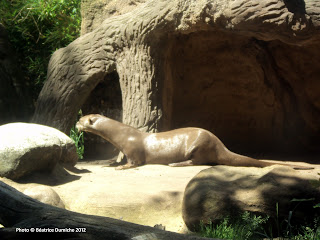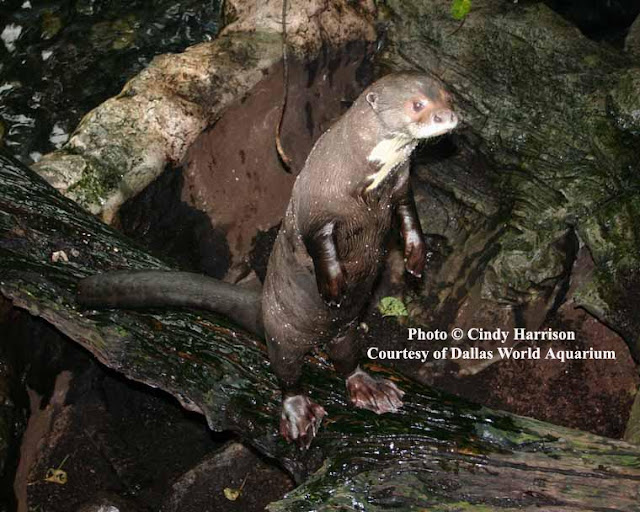Otter News is very excited to continue this excellent series on Zoo Duisburg and the Giant otters in their care. We also extend sincere appreciation to Béatrice Dumiche, Mr. Ulrich Kluckner, Dr. Jochen Reiter and Dr. Wolfgang Gettmann. To follow Otter News daily, click here.
Written & Submitted by Béatrice Dumiche
 |
| Beautiful giant otter sunning herself |
Picking up from Part II and the discussion of zoological policies, today’s post begins with a discussion of how modern technology can create methodologies for saving an endangered species such as the giant otter.
The example of how the giant otters can facilitate a new balance of coexistence between mankind and nature is striking. The zoo becomes a space that anticipates the movement between a highly developed technological civilization and wildlife conservation. It features that correctly understood ecology isn’t a step back to the middle Ages; but instead an agreement with technology and science. The sophisticated technology mankind now has at its disposal gives us the unique chance to modify the relationship between ourselves and nature by an interactive cooperation.
The protection of an endangered species like giant otters is thus significant for this gradual epistemological change leading to a new practice where biologists and keepers work together evaluating their specific competencies and cooperating with colleagues in other zoos which are associated via the breeding program. So, it was a normal procedure for Dr. Reiter and Mr. Kluckner to equally contribute to the public information. They reported on a common success that resulted from their different approaches to the same problems since practical responses often need the confluence of scientific research and zoology, which has to be validated by improvement through very concrete realizations. Additionally, creating the best breeding conditions requires teamwork based on communications involving the entire zoo staff.
 |
| Getting ready to swim |
Latest technology resources greatly assisted in realizing an otter pen that features the optimal natural environment according to the newest knowledge of the otters’ antics. In 2008, one year before the first pup was born, the enclosure was transformed; integrating the experience Zoo Dortmund* had with its own giant otters. Dr. Reiter stressed that the pen was enlarged to increase the land to water ratio as it was discovered by observation that giant otters spend more time on shore and need bigger topsoil areas in order to feel at ease. This is not to say, however, that they will live, properly speaking, in a reconstruction of their natural surroundings. It may look this way at the first sight, but actually the enclosure and exhibit is filled with well-hidden modern technology which adapts the German climatic and geographic conditions to the needs of the giant otters which are used to the subtropical environment of the South American continent. In fact, it is a well-balanced compromise as, with their dense and thick fur, the otters are able to acclimate to colder temperatures within a modified setting provided they find all they require to develop their natural abilities. So, within the exhibit, they enjoy lying down on spots in the outside landscape which are heated from the soil. In addition, between the inner and the outer pen, there is an entirely tiled room which functions as a toilet and as an airlock facilitating the transition for the animals between their heated inner quarters and the outdoor facilities. This transitional area is especially needed in winter, when the otters transfer daily to and from the outside except for the very rare times when they cannot get into the water because it is frozen.
 |
| Jumping & playing giant otters |
The advancement of technological efficiency is implemented for their physical health and for their general well-being although sometimes it does not work as it is supposed to because, like every intelligent living being, they remain unpredictable. Mr. Kluckner explained that staff determined the place where the otters used to defecate and installed some drainage under the sand. This must have caused the otters to “feel disturbed” as they promptly abandoned the spot and moved a bit further away from the well-placed drainage. Now, as if to tease their keepers, every time their toilets are drained, the otters change their place, wandering almost throughout the entire pen.
Nevertheless, the otter exhibit satisfies the most recent ecological standards, especially thanks to a water filtering system which permits recycling of most of the water used inside. This is just one way to reduce the high costs for keeping such a rare species and refute the critics arguing with sustainability as well as with more urgent social priorities. The animal welfare has its price, of course, because it requires intensive care by highly qualified and loyal staff as well as fresh food, which is quite expensive too. The costs for personnel represent 50% of the zoo budget while food and energy require 20 %. For instance, the giant otters get about 8 trout per adult. These are regularly delivered to the zoo by a local fish-farm because of the awareness that short distances increase the food quality and reduce transport fees and pollution as well. Thus, the spending is legitimized by the ecological and social causes it actually serves; a zoo may appear as a luxury in times of economic crises but only if its exhibits are not considered in the context of global educational and political challenges.
 |
| Walking along.... |
The example of the giant otters is a success story that shows how zoo policy can really set alternative standards at the zoological level. However, the example of the zoo’s giant otters also emphasizes the limits and contradictions which need to be overcome at a higher level. It advocates the conservation of nature in regions where giant otters are particularly threatened by ruthless exploitation conducted by international groups which are almost impossible to fight even in the framework of larger ecological programs because the effects are punctual and slow because they require significant education. Sadly, it appears still impossible to stop the lethal spiral of global over-industrialization, local poverty and the lack of education regarding the species; all of which are the major causes for the endangerment of the giant otter. At the moment, it is unthinkable to release zoo born otters in the wild, despite their being fit to a wild environment, because the factors which provoked their extinction remain as virulent today as they were in the past. The deforestation and the transformation of the large rivers into main traffic arteries used to transport natural resources like minerals and machines intensify the destruction of giant otter habitat. The otters’ presence within these large rivers further causes them to appear as a nuisance by the local fishermen, who don’t take any benefit of the wealth that is generated by foreign companies; rather, they suffer the same loss of their livelihood as the otters themselves because they are deprived of their local fishing grounds. This ecological rarefaction leads locals to more intensely hunt the animals for which they should be allies in order to retake control of what is done with their own traditional way of life. Concurrently, the otters are trapped for their fur, as they have been for centuries, because in a state of poverty and ignorance, which may also encourage corruption; official restrictions taken by governments without the means to enforce policies, are worth very little.

Next week, we conclude the series on the Giant otters of
Zoo Duisburg; stay tuned!
*Zoo Dortmund is located in the City of Dortmund, Germany. For information about their facility visit:
http://www.dortmund.de/en/leisure_and_culture/zoo/home_zoo/index.html





































